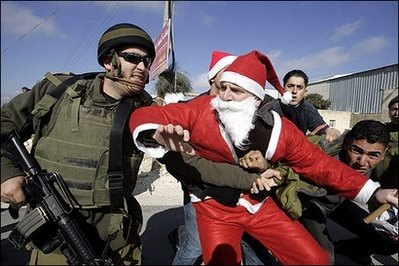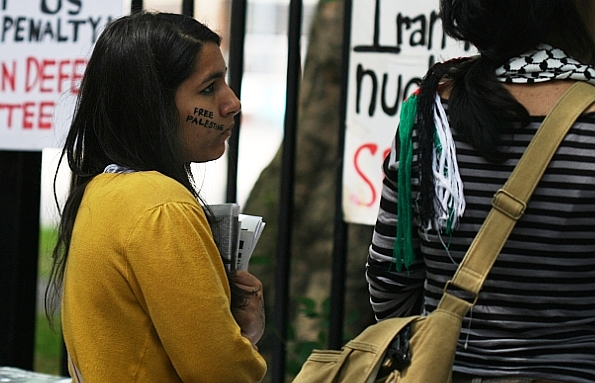Source(google.com.pk)
Israeli Occupation Of Palestine Biography
Serious human rights violations continued in 2011 in the Occupied Palestinian Territories (OPT). Israeli soldiers used unnecessary lethal force against demonstrators in the Israeli-occupied Golan Heights and across the border in Lebanon. Israeli military attacks in Gaza and policing operations in the West Bank resulted in the deaths of at least 37 civilians.
Israel continued to block exports from, and many imports to, the Gaza Strip, hindering the rebuilding of Gaza’s devastated economy. In the West Bank, including East Jerusalem, Israel demolished a record number of Palestinian homes under discriminatory practices, imposed severe restrictions on Palestinian freedom of movement, continued to build unlawful settlements, and arbitrarily detained peaceful protesters, including children.
Palestinian armed groups in Gaza launched hundreds of rocket attacks at Israeli population centers in 2011, killing two civilians and seriously injuring at least nine others; indiscriminate mortar attacks seriously injured at least four civilians in Israel. Another attack fatally injured an Israeli youth in a school bus. Egyptian attackers whom Israel claimed operated in coordination with armed groups in Gaza crossed the Egyptian border and killed six Israeli civilians.
Hamas authorities carried out three judicial executions in 2011 after unfair military trials, and allegedly tortured scores of detainees, some of whom died in custody.
The Palestinian Authority's (PA) security services arbitrarily detained hundreds of Hamas supporters as well as politically unaffiliated protesters who supported the pro-democracy Arab Spring movements and reconciliation between Hamas and Fatah. The PA also arrested journalists who were critical of the authorities. Credible allegations of torture by the PA's security services continued.
srael Defense Forces (IDF) conducted attacks on Gaza, including against smuggling tunnels and in response to rocket attacks, that killed 32 Palestinian civilians as of October, the Israeli rights group B’Tselem reported. The cases included civilians killed during aerial and artillery attacks, as well as IDF shootings of Palestinian civilians in the "no-go" zone along Gaza's northern and eastern borders. In April one Israeli aerial attack apparently targeted a Palestinian ambulance, while another aerial attack killed a mother and daughter in an area where no members of armed groups were present. In August an Israeli aerial attack on a sports club that witnesses said was not used for military purposes killed two civilians.
There were no further convictions for laws of war violations during "Operation Cast Lead," which ended in January 2009, despite individual IDF soldiers having allegedly intentionally killed civilians and the widespread, wanton destruction of civilian property. Israel previously convicted only three soldiers for crimes during the conflict, and only one received a prison sentence, for stealing a credit card. Hamas has prosecuted no one for indiscriminate attacks on Israel.Israel's punitive closure of the Gaza Strip, tightened after Hamas's takeover of Gaza in June 2007, continued to have severe humanitarian and economic consequences for the civilian population.
Gaza’s economy grew rapidly, but the World Bank said the growth depended on international assistance. The economy had not returned to pre-closure levels; daily wages, for instance, had declined 23 percent since 2007. Israel’s near-total restrictions on exports from Gaza hindered economic recovery. Due to low per capita income, 51 percent of the population was unable to buy sufficient food, according to UN aid agencies.
Israel allowed imports to Gaza that amounted to around 40 percent of pre-closure levels, the UN reported. Israel continued to bar construction materials, like cement, which it said had “dual use” civilian and military applications. Israel allowed shipments of construction materials for projects operated by international organizations, but as of September Gaza still had an estimated shortage of some 250 schools and 100,000 homes.
A report requested by the UN secretary-general found in September 2011 that Israeli commandos used excessive force in the killing of nine participants in the 2010 “Gaza Flotilla.” The report found that Israel’s naval blockade of Gaza was lawful, but did not address the human rights implications of Israel’s broader closure policy. Israeli officials had justified the closure in part as a means to pressure Hamas to release soldier Gilad Shalit, who was captured in 2006 and was released in October 2011 (see below).
Egypt shared responsibility for the closure of Gaza by restricting the movement of goods and people at the Rafah crossing on Gaza's southern border. In late May Egypt announced it would allow up to 400 Gaza residents to enter Egypt per day. By August more than 920 people per day crossed Rafah in both directions, compared to 1,320 people per day when the crossing was last fully operational in 2006. However, Egyptian border authorities continued to require Palestinians to present official identification cards, which cannot be issued without Israeli approval, even for Gaza residents. Egypt did not permit regular imports or exports through Rafah; in 2005 up to 8,600 truckloads of goods per month entered Gaza from Egypt.










Israeli Occupation Of Palestine Biography
Serious human rights violations continued in 2011 in the Occupied Palestinian Territories (OPT). Israeli soldiers used unnecessary lethal force against demonstrators in the Israeli-occupied Golan Heights and across the border in Lebanon. Israeli military attacks in Gaza and policing operations in the West Bank resulted in the deaths of at least 37 civilians.
Israel continued to block exports from, and many imports to, the Gaza Strip, hindering the rebuilding of Gaza’s devastated economy. In the West Bank, including East Jerusalem, Israel demolished a record number of Palestinian homes under discriminatory practices, imposed severe restrictions on Palestinian freedom of movement, continued to build unlawful settlements, and arbitrarily detained peaceful protesters, including children.
Palestinian armed groups in Gaza launched hundreds of rocket attacks at Israeli population centers in 2011, killing two civilians and seriously injuring at least nine others; indiscriminate mortar attacks seriously injured at least four civilians in Israel. Another attack fatally injured an Israeli youth in a school bus. Egyptian attackers whom Israel claimed operated in coordination with armed groups in Gaza crossed the Egyptian border and killed six Israeli civilians.
Hamas authorities carried out three judicial executions in 2011 after unfair military trials, and allegedly tortured scores of detainees, some of whom died in custody.
The Palestinian Authority's (PA) security services arbitrarily detained hundreds of Hamas supporters as well as politically unaffiliated protesters who supported the pro-democracy Arab Spring movements and reconciliation between Hamas and Fatah. The PA also arrested journalists who were critical of the authorities. Credible allegations of torture by the PA's security services continued.
srael Defense Forces (IDF) conducted attacks on Gaza, including against smuggling tunnels and in response to rocket attacks, that killed 32 Palestinian civilians as of October, the Israeli rights group B’Tselem reported. The cases included civilians killed during aerial and artillery attacks, as well as IDF shootings of Palestinian civilians in the "no-go" zone along Gaza's northern and eastern borders. In April one Israeli aerial attack apparently targeted a Palestinian ambulance, while another aerial attack killed a mother and daughter in an area where no members of armed groups were present. In August an Israeli aerial attack on a sports club that witnesses said was not used for military purposes killed two civilians.
There were no further convictions for laws of war violations during "Operation Cast Lead," which ended in January 2009, despite individual IDF soldiers having allegedly intentionally killed civilians and the widespread, wanton destruction of civilian property. Israel previously convicted only three soldiers for crimes during the conflict, and only one received a prison sentence, for stealing a credit card. Hamas has prosecuted no one for indiscriminate attacks on Israel.Israel's punitive closure of the Gaza Strip, tightened after Hamas's takeover of Gaza in June 2007, continued to have severe humanitarian and economic consequences for the civilian population.
Gaza’s economy grew rapidly, but the World Bank said the growth depended on international assistance. The economy had not returned to pre-closure levels; daily wages, for instance, had declined 23 percent since 2007. Israel’s near-total restrictions on exports from Gaza hindered economic recovery. Due to low per capita income, 51 percent of the population was unable to buy sufficient food, according to UN aid agencies.
Israel allowed imports to Gaza that amounted to around 40 percent of pre-closure levels, the UN reported. Israel continued to bar construction materials, like cement, which it said had “dual use” civilian and military applications. Israel allowed shipments of construction materials for projects operated by international organizations, but as of September Gaza still had an estimated shortage of some 250 schools and 100,000 homes.
A report requested by the UN secretary-general found in September 2011 that Israeli commandos used excessive force in the killing of nine participants in the 2010 “Gaza Flotilla.” The report found that Israel’s naval blockade of Gaza was lawful, but did not address the human rights implications of Israel’s broader closure policy. Israeli officials had justified the closure in part as a means to pressure Hamas to release soldier Gilad Shalit, who was captured in 2006 and was released in October 2011 (see below).
Egypt shared responsibility for the closure of Gaza by restricting the movement of goods and people at the Rafah crossing on Gaza's southern border. In late May Egypt announced it would allow up to 400 Gaza residents to enter Egypt per day. By August more than 920 people per day crossed Rafah in both directions, compared to 1,320 people per day when the crossing was last fully operational in 2006. However, Egyptian border authorities continued to require Palestinians to present official identification cards, which cannot be issued without Israeli approval, even for Gaza residents. Egypt did not permit regular imports or exports through Rafah; in 2005 up to 8,600 truckloads of goods per month entered Gaza from Egypt.
Israeli Occupation Of Palestine

Israeli Occupation Of Palestine
Israeli Occupation Of Palestine

Israeli Occupation Of Palestine

Israeli Occupation Of Palestine

Israeli Occupation Of Palestine

Israeli Occupation Of Palestine
Israeli Occupation Of Palestine

Israeli Occupation Of Palestine

Israeli Occupation Of Palestine

Israeli Occupation Of Palestine
No comments:
Post a Comment